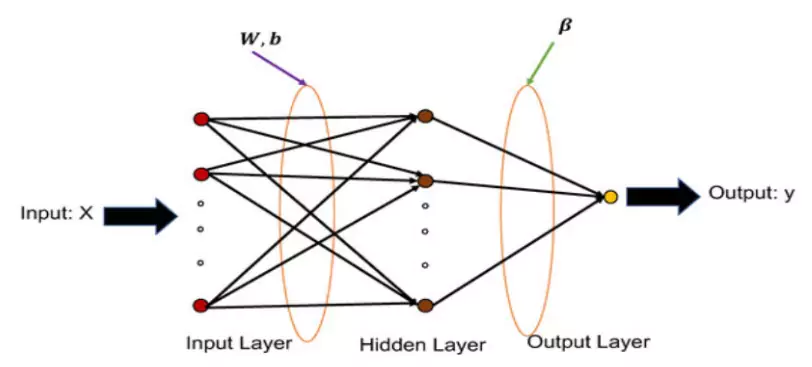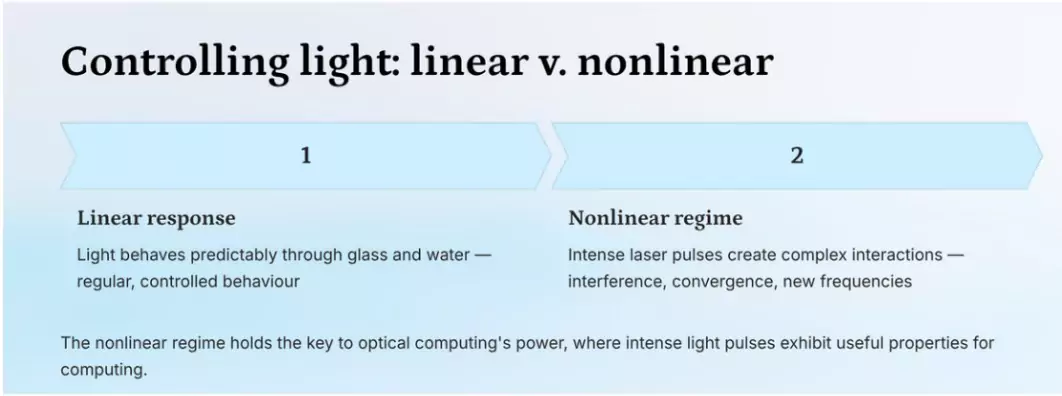Recent research in Finland and France demonstrated that optical fibres, traditionally used for data transmission, can also perform AI computations using the nonlinear behaviour of light.
- This opens possibilities for faster, energy-efficient AI systems, with transformative implications for science, governance, and global technology.
Artificial Intelligence, Hidden Layer & ELM
- Artificial Intelligence (AI): Simulation of human-like intelligence in machines to perform tasks such as pattern recognition, decision-making, and learning from data.
- A key approach in AI is the use of neural networks, which are computational models inspired by the human brain that process information through interconnected layers of artificial neurons.
- Hidden Layer: Intermediate stage in a neural network where raw inputs are transformed into useful features (e.g., edges, curves, loops in images).
- It is the “thinking space” of AI models, turning simple data into complex representations.
- Extreme Learning Machine (ELM): A simplified neural network with only one hidden layer.
- Input-to-hidden connections are random and fixed.
- Only output weights are trained, making it much faster than deep learning models.
- In the optical AI study: The fibre itself acted as the hidden layer, performing the transformation naturally through light physics.

|
Key Findings of the Research
- Discovery of Nonlinear Interactions: Researchers showed that intense light pulses inside glass fibres behave differently from normal light.
-
- Instead of passing smoothly, they mix, generate new frequencies, and create complex patterns that can be harnessed for computation.
- Use of Extreme Learning Machines (ELM): The experiments used ELMs, a simpler form of neural network with only one hidden layer.
- The optical fibre acted as this hidden layer, automatically transforming input data into usable patterns for classification.
- High Accuracy Achieved: The system achieved ~91–93% accuracy in recognising handwritten digits.
- This is nearly on par with electronic AI models, but achieved through physics of light rather than electronic transistors.
- Deterministic Behaviour of Light: Despite the seemingly chaotic mixing, outputs were consistent and repeatable for the same inputs.
- This predictability is crucial for using light as a computing medium.
Traditional Computers vs Light-Based Computing
- Electronics-Based Computing: Traditional systems use electrons moving through silicon chips.
- They operate sequentially, flipping billions of transistors to process binary code.
- While predictable, this generates heat and consumes significant energy, especially for AI workloads.
- Optical Computing with Photons: Light-based computers use photons, which travel at the speed of light and produce minimal heat.
- Data is encoded in properties of light according to the intensity, phase, and frequency.
- When these pulses pass through fibres, nonlinear optical effects transform them into complex fingerprints.
- Operational Advantage: Unlike step-by-step transistor operations, light transformations occur instantly and in parallel.
- This parallelism allows AI tasks to be completed faster and more efficiently
How Does Light Behave in Fibres?
- Light Waves as Carriers: Light can carry information by modulating its amplitude (brightness), phase (oscillation), or frequency (colour).
- Linear Behaviour: At low intensity, light behaves predictably.
- For Example: Similar to cars moving in separate lanes without interference.
- Nonlinear Behaviour: At high intensity, light waves interact, mix, and create new frequencies.
- Example: Like ripples in a pond that overlap when stones are dropped, but the overlap is mathematically consistent, not random.

What are Fibre Optic Cables and How Do They Work?
- Composition: Ultra-thin cylindrical strands of glass, about the diameter of a human hair, surrounded by protective layers.
- Principle: They rely on total internal reflection where light bounces repeatedly within the glass without escaping.
- Functioning:
-
- A transmitter converts information into pulses of light
- Optical fibres carry these pulses over long distances.
- A receiver decodes the signal back into usable information.
- Advantages
- Extremely high data transmission rates (several terabits per second).
- Resistant to weather disturbances, unlike copper or radio.
- Strong, flexible, and ideal for undersea cables or buried infrastructure.
- Proposed by Charles Kao ~60 years ago, fibre optics won him the 2009 Nobel Prize in Physics.
|
Benefits of Light-Based Computing for AI
- Speed Advantage: Photons travel faster than electrons and perform transformations instantly.
- This makes optical computing suitable for high-speed AI applications such as surveillance and disaster prediction.
- Energy Efficiency: Optical systems consume less power and generate less heat.
- With AI data centres already using ~1–2% of global electricity, energy-efficient computing could reduce costs and emissions.
- High Bandwidth and Parallelism: Light can carry multiple data streams at once without interference.
- This allows simultaneous processing of large datasets, making AI training faster.
- Sustainability Factor: Reduced energy use makes light-based AI greener and more aligned with global commitments to sustainable development.
Applications of Light-Based Computing for AI
- Healthcare: Optical AI could rapidly process medical scans such as MRIs and X-rays.
- This would support faster diagnosis, particularly important in India’s resource-constrained rural health sector.
- Defence and Security: Real-time recognition of patterns in surveillance footage and intelligence data.
- Could be critical for border security and missile defence systems.
- Governance and Administration: Faster analysis of large citizen datasets for schemes and welfare programmes.
- Could strengthen e-governance platforms under Digital India.
- Scientific Research: Used for simulations in climate modelling, genomics, or astrophysics where massive data must be analysed quickly.
Challenges & Limitations of Optical AI
- Technical Stability: Nonlinear effects must be carefully controlled.
- If light intensity is too strong or fibre too long, results become unstable and inaccurate.
- Experimental Constraints: Current models do not consider polarisation or phase variations of light.
- Future work must integrate these for real-world reliability.
- Scalability Issues: Optical computing is still experimental and requires costly photonic integrated circuits for mass adoption.
- Governance Concerns: Faster AI raises challenges of accountability and transparency.
- Unregulated systems could deepen biases or lead to opaque decision-making in governance.
- Ethical and Security Risks: Optical AI could be misused for intrusive surveillance or autonomous weapon systems.
- Global cooperation is needed to establish norms and prevent misuse.
Way Forward
- Strengthen R&D Investment: Prioritise optical AI in national technology missions and encourage private-sector participation.
- Skill Development: Introduce photonics + AI specialisations in IITs, IIITs, and NITs.
- Global Collaboration: Partner with EU, US, and Japan on photonic hardware and AI governance frameworks.
- Balanced Regulation: Create ethical guidelines for AI that also cover emerging hardware platforms.
- Integration with National Missions: Align optical AI research with Digital India and green energy goals to maximise societal benefit.
Conclusion
Light-based computing demonstrates how fundamental physics can transform the future of AI. By using optical fibres as computing elements, scientists have shown that AI can be faster, greener, and more efficient. While technical and governance challenges remain, the potential for revolutionising healthcare, governance, and research is immense.
![]() 24 Sep 2025
24 Sep 2025

